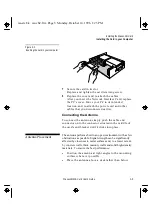
Installing the Software
Installation Procedure
3-6
WaveLAN/ISA Card User’s Guide
Create a
WAVELAN.INI file
3
The WaveLAN.INI file is used to tell the WaveLAN utilities
where to find configuration information relating to the
WaveLAN card. It contains a pointer to the network
configuration file you modified in the previous step “Driver
Configuration” on page 3-3. Use an ASCII text editor, such as
the MS-DOS EDIT program to create a file called
WAVELAN.INI, containing 2 lines:
●
full path filename of the configuration file.
●
type of driver installed (ODI or NDIS-2).
Example (ODI):
filename=c:\nwclient\net.cfg
filetype=netc
Example (NDIS):
filename=c:\wavelan\protocol.ini
filetype=prot
Copy the WAVELAN.INI file to the Utilities diskette you
created as described in “Create a Utilities Diskette” on
page 3-2.
Verify the Installation
3
Reboot your computer to verify that the network driver loads
correctly.
A message similar to one of the following is displayed when
the ODI driver loads successfully:
WLAN DOS ODI vX.xx (YYMMDD)
ISA XXXX MHz Roaming enabled Domain ID = xxxx Default
NWID=xxxx
Security Feature disabled
A message similar to one of the following is displayed
when the NDIS-2 driver loads successfully:
WaveLAN DOS NDIS 2 Driver vXX.xx
ISA XXXX MHz Roaming enabled NWID=xxxx Security Feature
disabled
Frequency Selection
(2.4 GHz)
3
If you have installed a 2.4 GHz card and intend to use it in
networks with older WaveLAN 2.4 GHz ISA cards, Micro
Channel cards or WavePOINTs you need to change the card's
isa-src.bk : isa-ch3.frm Page 6 Monday, October 14, 1996 1:23 PM






























